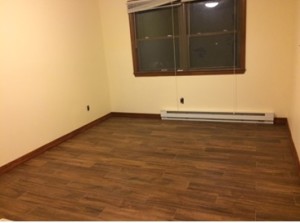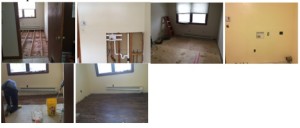Why is your Floor Lumpy?
Home-improvement projects are by far my favorites. In these projects, I’m one of the major stakeholders but also the project planner, budget approver, and end user.
Problem Identification: This February we embarked on a laundry room project in my house. The washer and dryer had always lived in the foyer/landing area in my kitchen. This inconvenient location made entering the house stressful. Picture entering the house in a small narrow hallway where the washer and dryer and two cats are crowding the entrance to the kitchen. Now picture yourself with a handful of groceries entering that same area. We needed a better configuration!
Planning: In order to move the washer and dryer to a new room, we had to move the electricity and plumbing but also outfit the room to be appropriate for laundry facilities. The room had carpet, which wouldn’t be suitable in case it got wet from an overflowing washer. After many trips to Home Depot and hours online researching floor options, we decided to tile the room. We had a few tile options that we liked and samples of each.
Execution: Once we found the contractor, we were ready to execute the project. The contractor happened to be my uncle, which made it easy to manage, in a way. But, it also posed challenges.
The old floor was torn out, new plumbing went in, and the electricity outlets were installed. Next, the subfloor was put in. It was time to go and purchase the tile. When I asked my uncle what type of tile would be best, he said any kind would work. We reviewed the samples and opted for the ceramic tile that looks like hardwood floors. The tiles were around 3 feet in length and 9 inches in width. The installation was going fine, but then they started to have problems. Instead of talking to me about the problems, the work slowed and it started to take longer to finish parts of the floor.
Issue Management: After he had left one day, I looked at the progress of the floor and noticed that some of the tiles were uneven. There were dips in the floor. The next morning I asked why the floor looked that way. He said because the floor was uneven they were having a hard time installing the tile we picked because it was so long. Had we chosen one of the smaller square tiles, he said this wouldn’t have been an issue because they contour to the subfloor better. This clearly should have been a conversation that we had before ordering and installing the tile. Wait! We did talk about the tile and he said any tile would do! Since it was my uncle, I couldn’t in good conscience make him rip out the tiles that he had already installed. I may have done so, had it been a purely business relationship.
Risk Management: This wasn’t a risk I had planned for, which unfortunately turned into an issue. My husband and I discussed the floor and made a decision to let him finish, accepting the fact that there would be small dips in the floor tiles. The reasoning was once the floor was grouted, the room had furniture, and the washer and dryer moved in, the floor dips may not be as visible.
Quality Management: The tile was completed and the grout was applied. We moved the furniture, washer, and dryer into the room. It was true that the dips are less noticeable, but I can still see them in the floor. Maybe it’s because I know that they are there. It looks like an antique wood floor, however it’s brand-new!
Success Metrics: I love that the project was completed and still consider it a success. Entering my house is no longer as stressful; it seems like I have tons of room now to take off my jacket and shoes, put down those groceries, and pet those cats. And who really cares if your laundry room floor is lumpy?


